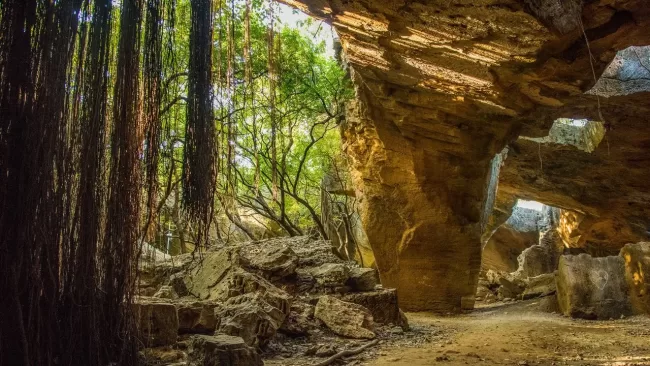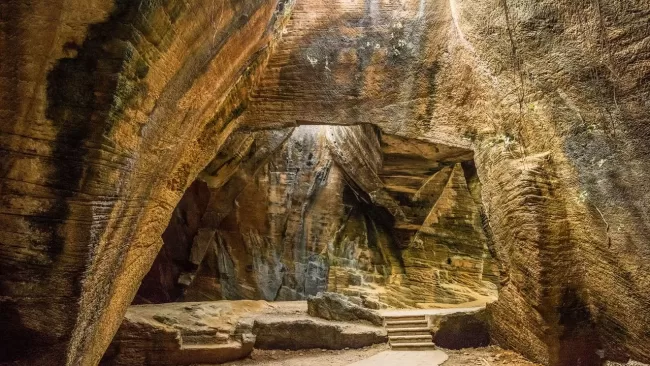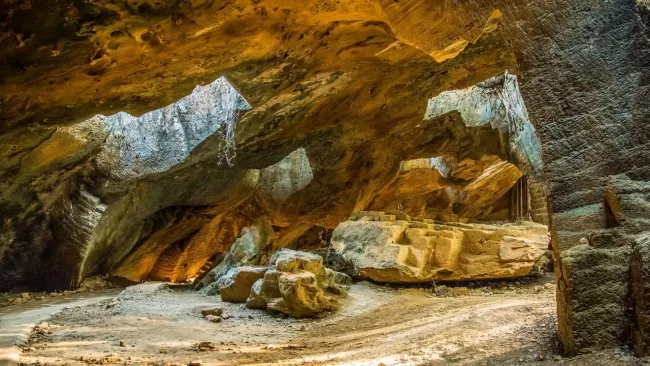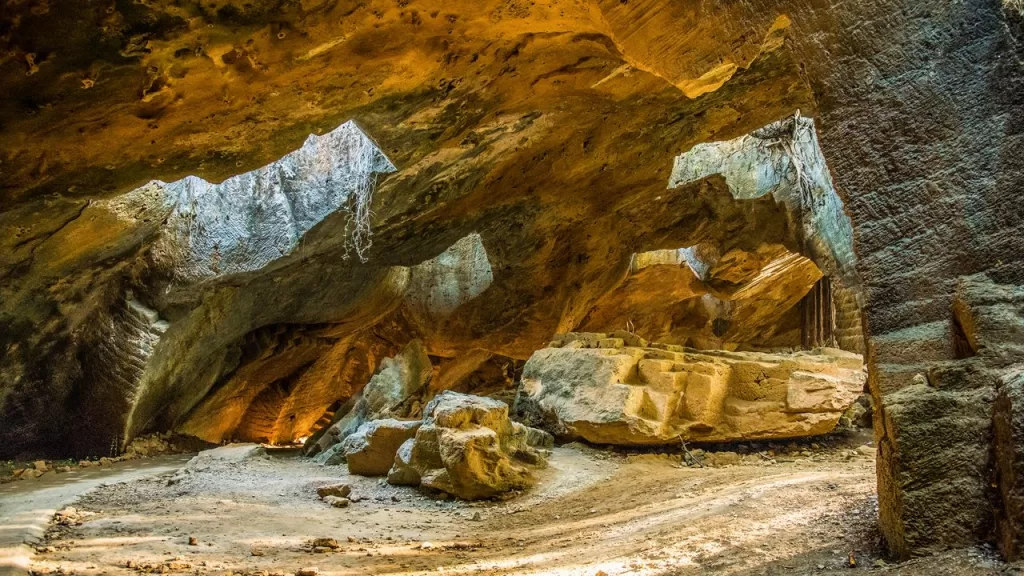Naida Caves, Shrouded in mystery and history, the Naida Caves promise an experience unlike any other. The origins of these caves are as intriguing as their appearance. Some believe they were carved by human hands, while others argue they are the result of natural forces at work over centuries.
During the Portuguese colonial era, Diu Fort served as a significant stronghold. According to legend, the Portuguese quarried building materials from these caves to construct the fort. Over time, natural weathering and erosion sculpted the caves into their current form, a labyrinth of tunnels interspersed with square-hewn steps. Whether crafted by human ingenuity or nature’s artistry, the Naida Caves silently bear witness to a rich and complex past.

Naida Caves An Ethereal Escape
Stepping into the Naida Caves is like entering another world. The irregular terrain, interconnected tunnels, and concealed grottoes create a captivating maze, inviting visitors to explore its depths. The interplay of light and shadow within the limestone walls enhances its enchanting ambiance, making it a visual and sensory treat.
ALSO READ: The Gateway of India: Mumbai’s Iconic Landmark
Traces of Portuguese Influence in Naida Caves
Echoes of the Portuguese era linger within the cave’s contours. The limestone used for Diu Fort left behind scars and shapes in the caves, resulting in a unique landscape of troughs and crests. These marks not only define the caves’ appearance but also connect them to the region’s colonial history, blending natural beauty with historical significance.
Entrances and Pathways
Naida Caves invite exploration through a variety of intriguing entrances. Some pathways are marked by neatly arranged rectangular steps that guide you across the rocky terrain. Others open up with wide passages, encouraging a deeper dive into the cave’s mysterious depths. Follow the red arrows etched into the stone, and let them lead you through this subterranean wonderland.

The Historical Enigma of Naida Caves
The Naida Caves are shrouded in an air of mystery, leaving room for endless speculation about their purpose. Were they a hidden sanctuary, a secret meeting place, or something more? According to local lore, when the Portuguese resisted leaving Diu and Operation Vijay was launched by the Indian Army. Several Portuguese soldiers sought refuge within these caves. The silent walls of Naida Caves still hold whispers of these long-gone days, adding layers of intrigue to their history.
A Photographer’s Delight
Naida Caves present a perfect setting for photographers, offering a stunning play of light and shadow. As sunlight filters through the crevices, it bathes the rugged surfaces in soft, ethereal light. Capture the striking contrasts as you wander through the cave’s dimly lit passages, finding beauty in every angle and corner.
An Uncommon Escape
Nestled among Diu’s sunny beaches and historic forts, Naida Caves provide an unexpected retreat. The cool, damp interiors offer a welcome respite from the heat. Making the caves an ideal spot for reflection and wonder. Step into this tranquil environment and discover a space that invites you to explore beyond the ordinary.

Discover More in Diu
Diu is rich in diverse attractions that beautifully complement the captivating Naida Caves. Here are some must-visit spots to enhance your experience in this charming destination:
Diu Fort:
This grand 16th-century Portuguese fort offers sweeping views of the sea and houses ancient cannons and a lighthouse, providing a glimpse into Diu’s colonial past.
Gangeshwar Temple:
Located about 3 km from Diu town, this unique temple features five shivlings placed amidst rocks on the seashore, continuously washed by the waves of the sea.
St. Paul’s Church:
A stunning example of 17th-century baroque architecture, this church is dedicated to Our Lady of Immaculate Conception and stands as a testament to Diu’s rich religious history.

INS Khukri Memorial:
A tribute to the crew of the INS Khukri, an Indian naval ship that sank during the 1971 Indo-Pakistani War, this memorial commemorates their bravery and sacrifice.
Diu Museum:
Housed within the St. Thomas Church, this museum showcases a collection of antique statues, stone inscriptions, wooden carvings, idols, shadow clocks, and more, offering insight into the region’s cultural heritage.
Zampa Gateway:
A historical gateway that holds a chapel dating back to the medieval era, Zampa Gateway is an important landmark that reflects Diu’s rich history.
Jalandhar Shrine:
Perched on a hill near the beach, this shrine is associated with the mythological demon Jalandhar and offers panoramic views of the surrounding landscape.

Chakratirth Beach:
A peaceful beach close to the town centre, perfect for unwinding and enjoying stunning sunset views.
Ghoghla Beach:
A serene and less crowded beach with golden sands, ideal for relaxation and water sports activities.
Simbor Beach:
Situated near the Gujarat border, this tranquil and scenic beach offers an escape into nature’s beauty and calm.
As the Arabian Sea serenades the rocky shores, Naida Caves stand as a powerful testament to resilience and transformation. Inviting all who visit to reflect on its past and appreciate the stories it holds. Whether shaped by human hands or nature’s own, these caves offer an exploration of history, imagination, and connection.


